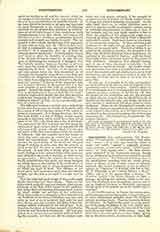

Counterpoint (Lat. contrapunctum; Ger. Kontrapunkt; Fr. contre point; It. contrapunto), from punctum, “point”—as a note was formerly called in music—and contra, “ against”; originally, punctum contra punctum, or notes contra notam—” point against point”, or “note against note”. The term counter-point originated in the fourteenth century, though the art designated by it had been practiced for several centuries previous. The desire for harmony, that is, the simultaneous sounding with the cantus firmus, tenor, or theme, of one or more voices on different intervals, first found expression in the so-called diaphony or “Organum” of Hucbald (840-930 or 932). [H. E. Woolridge in his “Oxford History of Music” (1901), vol. I, p. 61, quotes from a treatise “De divisione natur”, by Scotus Erigena (d. 880), a passage, describing the organum, which would indicate that diaphony, even in contrary motion, was in use in England previous to Hucbald’s innovation, though proof of its general use in the British Isles is wanting.]
In the twelfth century, in France, the custom arose, and became general among singers, of improvising one or more independent melodies above the liturgical melody, or cantus firmus. This was known as dechant, or discantus. In England the gymel, or cantus gemel lus (twin song), flourished at an even earlier date. The gymel consisted in adding the interval of the third both above and below the cantus firmus. Later, the third below was transposed an octave higher, giving rise to the /also-bordone, faux-bourdon, or false bass.
All these sporadic attempts at polyphony culminated, in the fourteenth century, in the addition of different melodies to the cantus firmus in accordance with well-formulated laws of counterpoint which are still valid at the present day. The aim was the perfect integrity and independence of the various melodies in their flow, from which, of course, resulted passing dissonances, but these were continually solved into consonances on the accented notes of the measure. During the course of the following century contrapuntal skill reached unprecedented heights among both the numerous masters of the Netherlands and those of England; but it served its highest purpose and bore its ripest fruit in the Roman school of the sixteenth century. The polyphony for four, five, six, eight, or more parts, produced in that century, with its prevailing consonance and unifying and life-giving principle, the cantus firmus (generally a Gregorian melody), is, in a sense, an image of the congregation or of the Church itself. We have unity in variety: each voice singing its own melody and still harmonizing with every other voice, just as every member of the Church aspires to the same ideal according to his own nature and capacity. When monody came into fashion at the end of the sixteenth and the beginning of the seventeenth century, the study and practice of counterpoint was almost entirely neglected, but it received a new and wonderful development at the hands of Handel and Bach. For a time contrapuntal art served masters other than the Church and her liturgy, but with the revived observance of her laws in regard to music, and with the study and revival, during the past sixty years, of her greatest musical treasures, counterpoint in accordance with its original principles, has come into its own again and is bearing fruit as it did of yore.
JOSEPH OTTEN

